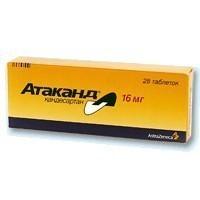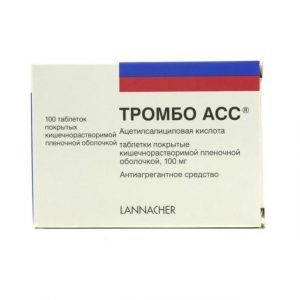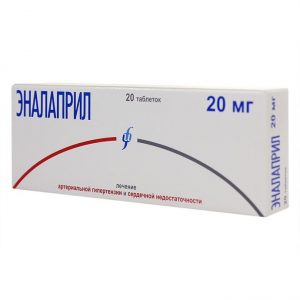Description
Latin name
Atacand
Release form
Tablets.
Packing
28 pcs.
Pharmacological action
Atacand has a hypotensive effect.
Selectively blocks angiotensin II receptors (type AT1).
Indications
Arterial hypertension.
Contraindications
Hypersensitivity to pregnancy, breast-feeding, children.
Use during pregnancy and lactation
The drug is contraindicated in pregnancy.
In experimental studies found that the use of candesartan leads to impaired renal function in the fetus in the late stages of development, as well as in the neonatal period. The mechanism of this action is probably related to the effect of the drug on the renin-angiotensin-aldosterone system.
In humans, renal perfusion of the fetus, which depends on the state of the renin-angiotensin-aldosterone system, begins in the second trimester of pregnancy. Thus, the risk to the fetus increases when taking the drug in the II trimester.
It has not been established whether candesartan is excreted in breast milk. If it is necessary to use the drug during lactation, breast-feeding should be discontinued due to the potential for the development of negative side effects in the child.
In experimental studies, candesartan was found in the milk of lactating rats.
Composition
1 tablet contains 16 mg candesartan cilexetil.
Dosage and administration of
Atacand is recommended in a dose of 8 mg 1 time / day. The maximum therapeutic effect is achieved 4 weeks after the start of therapy. In the absence of the necessary clinical effect, the dose can be increased to 16 mg / day.
Tablets are taken 1 time / day, regardless of food intake.
When prescribing the drug to the elderly, patients with mild or moderate impaired renal function (CC> 30 ml / min / 1. 73 m2) or with chronic liver diseases of mild or moderate severity, correction of the dosage regimen is not required.
When prescribing the drug to patients with severe impaired renal function (KK2), the initial dose should be 4 mg.
Clinical data on the use of the drug in patients with severe liver disease (cirrhosis) are absent. In this regard, such patients are recommended to begin treatment with a daily dose of 4 mg.
The drug can be used both as monotherapy and in combination with other antihypertensive drugs (thiazide diuretics, calcium channel blockers).
Side effects of
From the side of the central nervous system: often (more than 2%) – headache, dizziness.
On the part of laboratory parameters: increased AST activity (slightly higher than in the placebo groups). In general, no clinically significant changes in laboratory parameters were detected with Atacand.
Other: often (more than 2%) – back pain.
Clinical trials revealed good tolerance to the drug, the incidence of side effects was comparable to placebo, did not depend on the dose of the drug, as well as on the age and gender of the patient. In general, side effects were moderate and temporary. The number of cases of drug discontinuation due to side effects occurred was similar to their number in the group of patients taking candesartan cilexetil and placebo.
A causal relationship between Atacand administration and the described side effects has not been established.
Drug Interaction
Interaction with Other Drugs and Other Forms of Drug Interaction
Pharmacokinetic studies have investigated the combined use of Atacand with hydrochlorothiazide, warfarin, digoxelamine, peroralestral No clinically relevant drug interactions were identified.
Candesartan is poorly metabolised in the liver (CYP2C9). Interaction studies did not reveal the effect of the drug on CYP2C9 and CYP3A4, the effect on other isoenzymes of the cytochrome P450 system has not been studied.
Co-administration of Atakand with other antihypertensive agents potentiates the antihypertensive effect.
Experience in the use of other medicines acting on the renin-angiotensin-aldosterone system shows that concomitant therapy with potassium-sparing diuretics, potassium supplements, potassium-containing salt substitutes, and other agents that can increase serum potassium (eg, serum, can lead to the development of hyperkalemia.
Concomitant administration of lithium drugs with ACE inhibitors has reported reversible increases in serum lithium concentrations and the development of toxic reactions. Similar reactions may occur with the use of angiotensin II receptor antagonists, and it is therefore recommended to control serum lithium levels when combined with these drugs.
The bioavailability of candesartan is not dependent on food intake.
overdose Symptoms of
The analysis of the pharmacological properties of the drug suggests that the main manifestation of overdose may be clinically pronounced BP and dizziness. Separate cases of drug overdose (up to 672 mg candesartan cilexetil) have been reported and have resulted in patients recovering without serious consequences.
Treatment of
In the development of clinically pronounced arterial hypotension, symptomatic treatment and the patient’s condition should be monitored. Lay down the patient, raise the head end of the bed. If necessary, the volume of circulating plasma should be increased, for example, by intravenous administration of isotonic sodium chloride solution. Sympathomimetic drugs may be prescribed if necessary. Withdrawal of candesartan by hemodialysis is unlikely.
Storage conditions
The drug should be stored at a temperature below 30 ° C.
Expiration
3 years.
Deystvuyuschee substances
candesartan
pharmacy delivery terms
dosage form
dosage form
tablets
AstraZeneca, Britain




